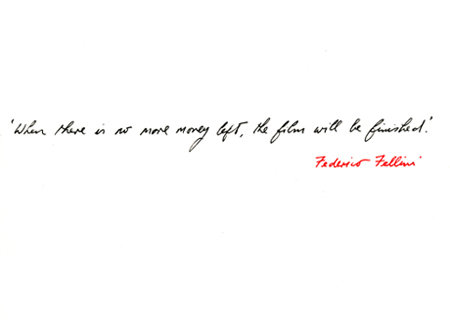John Murphy
dal 28/11/2008 al 6/2/2009
Segnalato da
28/11/2008
John Murphy
Galerie Erna Hecey, Bruxelles
Preoccupied with resonances betweens the different realms of the senses, the artist's oeuvre is especially concerned with the relationship between vision, representation and words. His works often evoke the themes of longing, absence and sexuality, and are characterized by their exquisite refinement and precision.

'When there is no more money left, the film will be finished'
Federico Fellini
Erna Hecey Gallery is pleased to present a solo exhibition by John Murphy.
Film (film), sb. [OE. filmen membrane = OFris. filmene skin :- WGmc. *filminja,
ult. f. *fellam FELL sb.1 ] 1. A membrane - 1764. 2. A thin pellicule or lamina of
any material 1577. 3. Photogr. A thin pellicule or coating of collodion, gelatin,
etc., spread on photographic paper or plates, or used by itself instead of a plate
1845. 4. A morbid growth upon the eye. Also fig. 1601. b. A celluloid roll of film
used for a cinema picture 1897. c. A cinema performance. 5. transf. A slight veil
of haze, mist, or the like. lit. and fig. 1833. 6. A fine thread or filament 1592.
7. Comb., as f. actress, -camera, star.
2. An icy gale . . o'er the pool Breathes a blue f. THOMSON. 4. He from thick
films shall purge the visual ray POPE. Phr. The f. of death. 6. When . . floating
films envelope every thorn COWPER.
André Bazin argued in one of his essays for a "mixed" cinema, that is, for a
cinema that would be enriched by its borrowings from the other arts. Alain Badiou,
taking up and radicalizing this thesis, describes cinema as "an impure art," "the
'plus-one' of the arts, both parasitic and inconsistent." For Badiou cinema is an
inherently hybrid medium, taking from theater, literature, music, painting, and so
on, without having a 'proper' domain. "Cinema is the seventh art in a very
particular sense. It does not add itself to the other six while remaining on the
same level as them. Rather, its implies them [...] It operates on the other arts,
using them as its starting point, in a movement that subtracts them from
themselves." (Handbook of Inaesthetics transl. Alberto Toscano, pp. 83, 79). What
is unique to cinema is the way that it mobilizes the different arts so that they
become contaminated with one another, thus creating an impure, heterogeneous
space: a supplement or a 'plus-one', rather than a Gesamtkunstwerk-style
synthesis. Likewise, Murphy's exhibition, making use of multiple cinematic
references, plays with the hybrid, supplementary nature of film, translating its
intrinsically mixed character back into the domain of visual art.
Preoccupied with resonances betweens the different realms of the senses, John
Murphy's oeuvre is especially concerned with the relationship between vision,
representation and words. Murphy's art historical lineage can be traced through a
European Symbolist-based conceptual tradition descending from Mallarmé and Jarry
through to Duchamp, Magritte and Broodthaers. His works often evoke the themes of
longing, absence and sexuality, and are characterized by their exquisite
refinement and precision. Speaking of Murphy's paintings, critic Michael Newman
has written, "They are concerned with limits--the limits of both art and life--in
a way which, taken seriously, becomes disturbing. Art becomes the place where
solitude, unfulfillable desire and death can no longer be forgotten."
John Murphy was born in 1945 in England. His recent solo exhibitions include ...
the stench of shit ..., Erna Hecey Gallery, Brussels (2007) Between the Acts,
Lisson Gallery, London (2006), Up or Down it's All the Same: in Gent or Venice,
Het Kabinet, Gent (2005), And Things Throw Light on Things, Ikon Gallery Barber
Institute, Birmingham (2004-2005), Of Voyages, Galerie Erna Hecey, Luxembourg
(2003), and The Way Up and the Way Down, Southampton City Art Gallery and Museum,
Southampton (1999). He works and lives in London.
Opening Saturday 29 November 2008 5-8 pm
Galerie Erna Hecey
rue Des Fabriques 1c - Brussels
Tuesday to Saturday from 2 to 7 pm and by appointment
Free admission



